Highlights
- Take a mythology and museum tour in bustling Athens
- Learn traditional fishing techniques in the Aegean Sea
- Try locally-produced cheese, wine, and olive oil in a Cretan village
- Discover Santorini's prehistoric city, hidden under volcanic ash for millennia
- Ride horses in Naxos, a lesser-known gem of the Cyclades
Brief Itinerary
| Day | Highlights | Overnight |
|---|---|---|
| Day 1 | Arrive in Athens | Athens |
| Day 2 | Acropolis and Ancient Greek Mythology & Museum Tours | Athens |
| Day 3 | Fishing Boat Adventure in the Saronic Gulf | Athens |
| Day 4 | Visit Kallimarmaro, Ancient Cooking Class | Athens |
| Day 5 | Athens to Chania | Chania |
| Day 6 | Old Town of Chania Tour | Chania |
| Day 7 | Vamos Cretan Delicacies Experience | Vamos |
| Day 8 | Vamos Village Hike | Vamos |
| Day 9 | Rethymno, Knossos, and Heraklion | Heraklion |
| Day 10 | Arrive in Santorini, Hidden Gems Tour & Wine Tasting | Santorini |
| Day 11 | Santorini Catamaran Cruise | Santorini |
| Day 12 | Discover Prehistoric Akrotiri | Santorini |
| Day 13 | Ferry to Naxos | Naxos |
| Day 14 | Ancient Naxos Hike | Naxos |
| Day 15 | Horseback Riding in Naxos | Naxos |
| Day 16 | Naxos to Athens and Depart |
Detailed overview
Day 1: Arrive in Athens
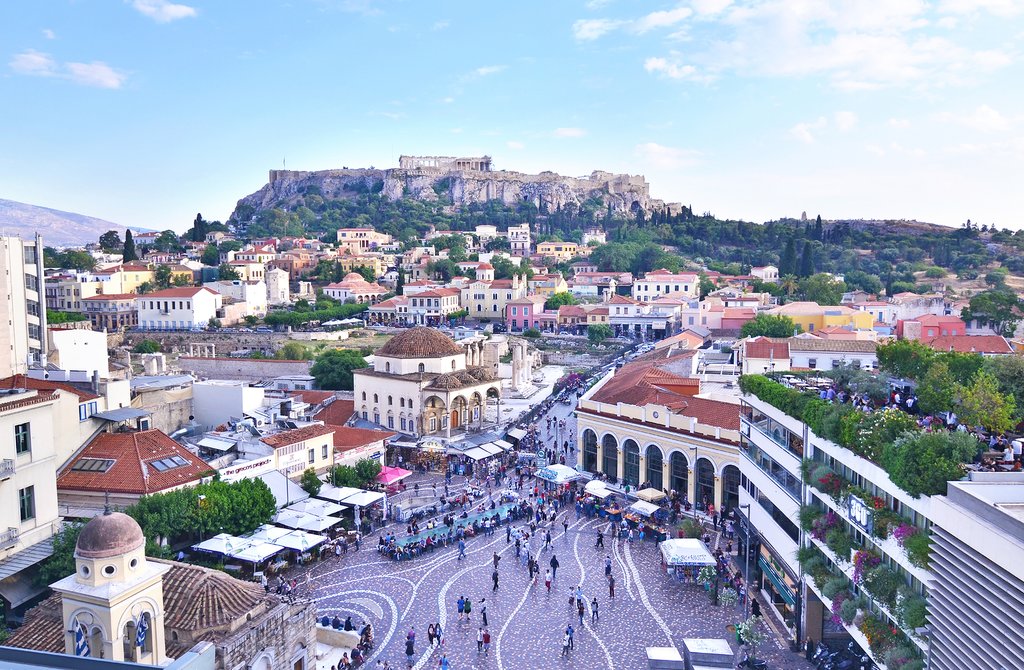
Welcome to Greece! You'll begin your trip in Athens, home to both the iconic Acropolis and so much more. The mythology of this spectacular city precedes it, with towering temples to Classical deities and the ruins of ancient marketplaces rubbing shoulders with lively nightlife, crowded flea markets, and contemporary cuisine. Make the most of your time in the city at some of these spots:
- Check out the views of the can't-miss Parthenon. (Pro tip: The Parthenon is the temple, the Acropolis is the hill.) This temple to Athena has enchanted visitors since its construction was completed in 438 BC. It's probably the first thing that comes to your mind when you think of ancient Greece and is visible from many of the city's high points.
- Stop at the sprawling National Museum for a crash course in ancient iconography. Be sure to seek out the room housing the Antikythera mechanism, essentially an ancient astronomical computer.
- Visit a smaller archaeological site at the Tower of the Winds, then stroll down neighboring pedestrian Aiolou Street to stop at shops and cafes.
- Find your perfect souvenir or sun hat in the busy stalls of the Monastiraki flea market.
Spend your evening exploring the up-and-coming Pangrati neighborhood or amid the nightlife and mezze of the Psyrri district.
Day 2: Acropolis and Ancient Greek Mythology & Museum Tours
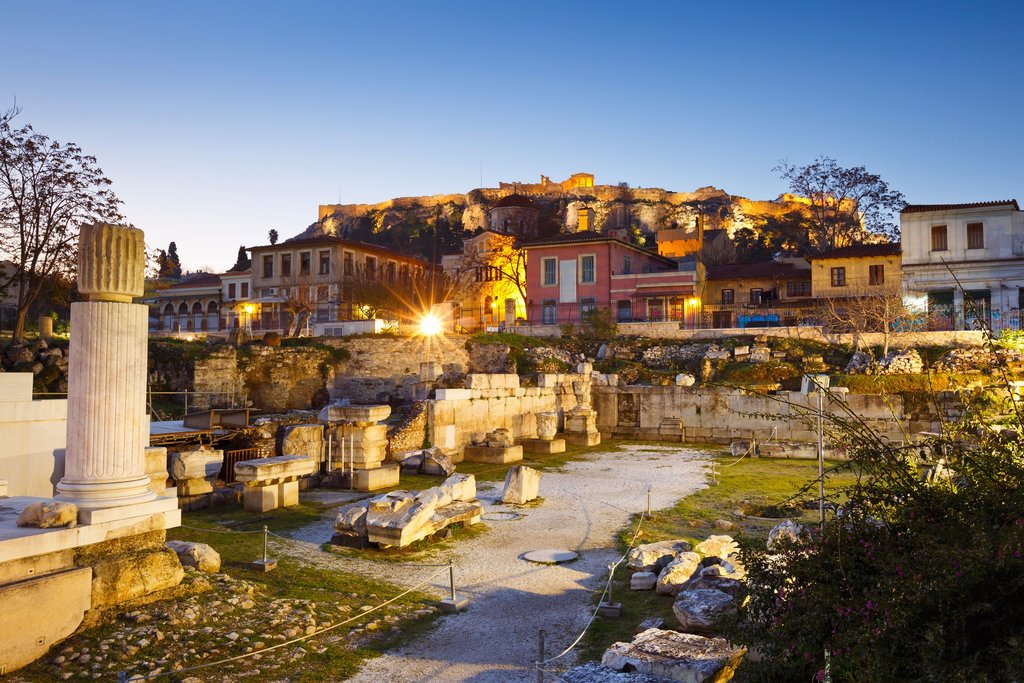
Experience the ancient stories surrounding you with today's guided mythology tour. You'll meet your guide and storyteller at the Temple of Olympian Zeus, then head to landmarks around the city including the Acropolis, ancient cemetery at Kerameikos, and the Agora. The myths that founded the city and are featured in its retellings for generations will accompany as you go, with stories of Zeus, Athena, Poseidon, Dionysus, and more. Hear both the stories themselves and the historic facts behind them, adding resonance to the archaeological ruins you will visit during this four-hour tour.
Stick with the supervised experience with another guided tour at the Acropolis Museum in the afternoon. Named one of the ten best museums in the world by National Geographic, this modern museum houses a multitude of artifacts removed from the hill of the Acropolis for safekeeping to provide insight into ancient religious practices and daily life. Linger for lunch in the museum's cafe, with views of the artifacts' former hilltop home.
As night falls, visit the Athens Observatory to learn about the constellations overhead and take a look through the telescope.
Day 3: Fishing Boat Adventure in the Saronic Gulf

Hop onboard with a professional fisherman to get up close and personal with the Saronic Gulf. You'll start in Athens' port suburb of Piraeus in Pasalimani, the port's hub for small fishing boats. Board a kaiki, a traditional fishing boat, where your fisherman guide will teach you all about their fishing techniques. Take in the scenery as you sail out to your first fishing grounds, where you'll observe traditional paragadi fishing methods.
Your second stop will be Fleves island, where you can put these lessons into practice with a provided fishing rod or join the fish instead, with a swim in the clear waters. Lunch will be served onboard (fish included, naturally) before you head back to check the paragadi for any fresh catches. The day's spoils will be divided for you to take back with you and enjoy later at your leisure.
Once you've returned to shore, check out Piraeus in the evening light before you return to the city center. Stroll through Pasalimani, then stay for a drink or two in one of the open-air cafes along the Gulf of Zea.
Day 4: Visit Kallimarmaro, Ancient Cooking Class
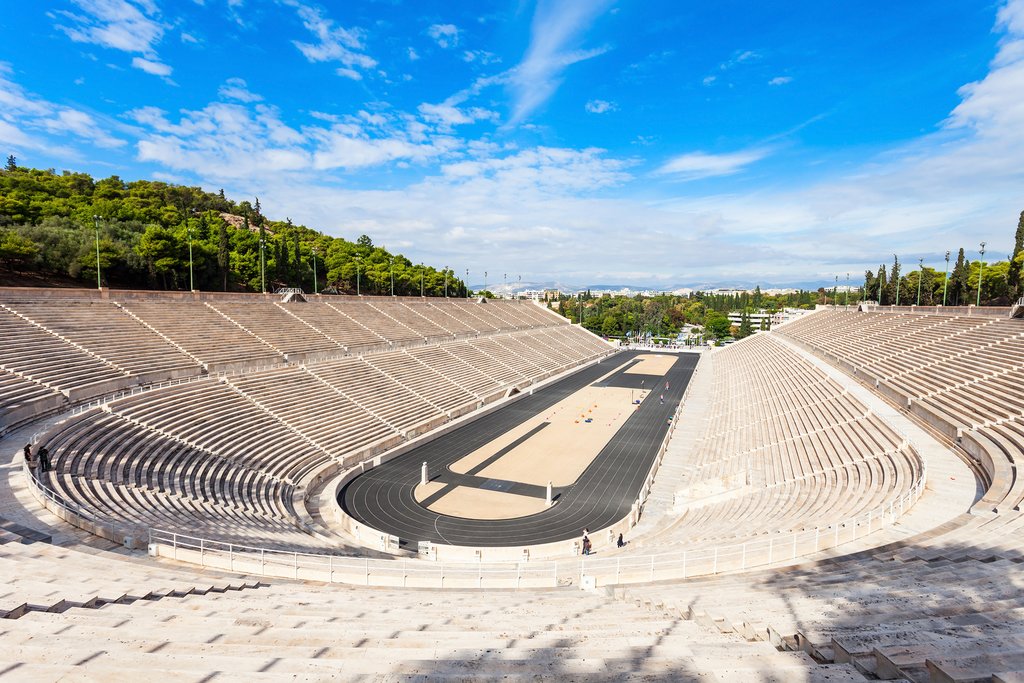
Start off the morning with a trip to the sweeping stands of Kallimarmaro, also known as the Panathenaic Stadium. The grand facility made entirely of marble was constructed in 1896 to host the first modern Olympics and is made entirely out of marble to honor the ancient stadiums.
Once you've been sufficiently inspired to feats of athleticism, you'll move on to feasts of Greek cuisine instead. A resident chef will take you on a journey of discovery into the methods used by the Ancient Greeks to cook their meals. You'll use ingredients available today to reproduce the distinct flavors found in classical dishes over the course of this 3-hour class. And no class is complete without the opportunity to sample the fruits of your labor over dinner (with wine included, of course).
Day 5: Athens to Chania
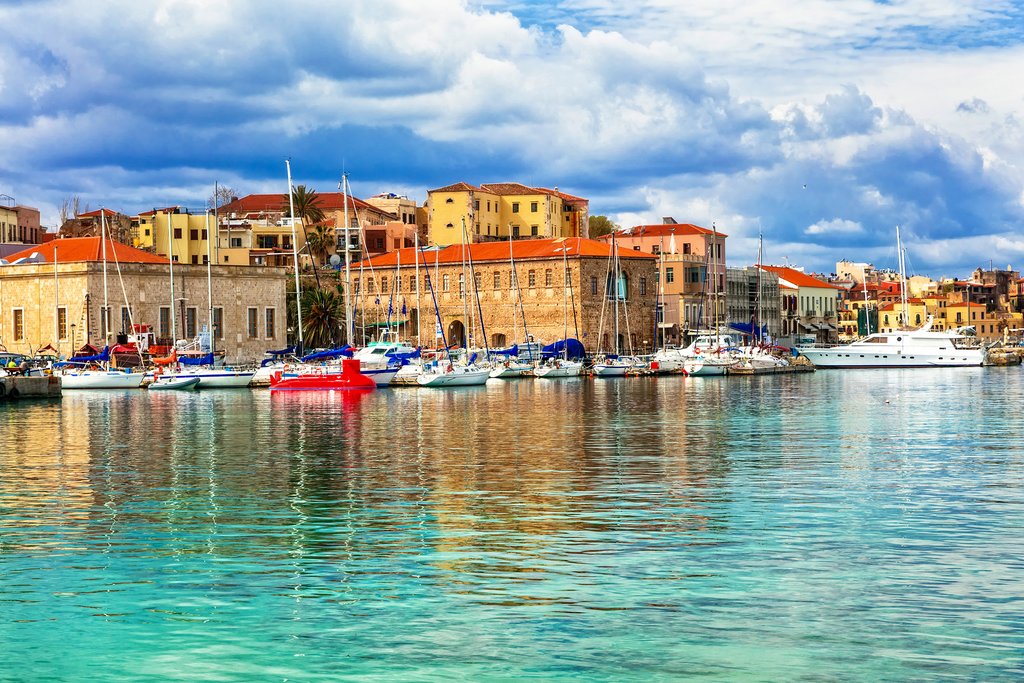
Your short flight today will take you to Crete, the largest and most populous of the 230 inhabited Greek islands. Upon arrival to Chania, a city (and region) on the northwest coast, you'll be transferred to your hotel as you get ready to explore this stunning island, equipped with tips from your local specialist.
Chania itself will be the main base of your operations during your trip. It's the second largest city in Crete and one of the most scenic spots on an island with stiff competition for that title. Life in this former Venetian city revolves around its charming 14th-century harbor, narrow streets with winding alleys, and colorful architecture influenced by past Ottoman and Egyptian eras.
Depending on what time you arrive, wander around town or head for one of the western region's spectacular beaches such as Falassarna and Elafonissi. There are also plenty of deserted coves and quiet bays to enjoy total privacy.
For dinner, wander around Chania's harbor and check out a slew of waterfront restaurants with a sunset view.
Day 6: Old Town of Chania Tour

Today, you'll experience the streets, buildings, high spots, neighborhoods, and monuments that only locals know with a guided tour. Walk the stone paths where the Venetians, the Ottomans, and older generations of Cretans used to live and work, admiring the flower-decorated neighborhoods. You'll learn about Cretan history, the Cretan mythology and traditions, meet the locals, and eat like the locals.
Visit the neighborhoods of Topanas, Splantzia, Kolombo and Kasteli, along with high spots to admire the panoramic view of the harbor, as well as traditional Cretan taverns and magnificent buildings. You'll also see the ruins of the great Minoan city of Kydonia and high walls of former Venetian moats now integrated into the city.
When hunger strikes, visit the Municipal Market of Chania and neighboring Municipal Garden to enjoy a coffee amid the shade of the trees or garden clocktower. Then, top it off with a sunset drink on the rooftop at trendy Pallas.
Chat with a local specialist who can help organize your trip.
Day 7: Vamos Cretan Delicacies Experience

Vamos village's lush greenery and natural scenery will set the stage for your discovery of local food production. Here, you can choose between two different tours.
Your first option is a cheese and olive oil experience, complete with the company of the kri-kri goats running wild. Crete is known for its graviera cheese, a slightly sweet, hard sheep cheese. Sample the graviera along with fresh-pressed olive oil. You'll also learn how goat and sheep bells are made for the farm's residents, a craft that is only known to a few people today.
If you're more of a wine enthusiast than cheesehead, option two is an olive oil and wine tasting experience. You'll begin with an introduction to the olive-oil-making process in a local facility. Then visit a winery, where the experts will give you a tour followed by a tasting accompanied by traditional mezze.
Walk off all those samples with an afternoon stroll around Vamos, surrounded by local history and hospitality, before spending the night in your traditional guesthouse.
Day 8: Vamos Village Hike

After breakfast, you'll keep up the leisurely pace with a stroll around the village of Vamos. You'll then spend roughly four hours exploring and sampling Cretan hospitality—with emphasis on the sampling, as you'll enjoy tastes of local food and drink along the way. This is also an opportunity to trek between the charming stone architecture of nearby villages while your guide teaches you about their history and everyday life through the ages. Cap it off with a glass of tsikoudia, a grape-based brandy.
Head back to your village lodging to relax for the afternoon before a traditional dinner. Don't miss the dakos salad, a traditional dish consisting of fresh tomatoes and creamy sheep or goat cheese served atop crunchy barley rusks and topped with olive oil and spices.
Day 9: Rethymno, Knossos, and Heraklion

After breakfast, you'll venture out to the aristocratic seaside town of Rethymno—the island’s intellectual and cultural capital. Wander around the town's lively Venetian harbor, check out the town's 19th-century lighthouse, or take a stroll along the sandy Rethymno beach.
Next, visit the city of Heraklion and archaeological site at Knossos, roughly an hours' drive away. Start by visiting Heraklion's Archaeological Museum, home to one of the largest collections of Minoan artifacts in the world. This is an excellent crash course for the next stop, located just outside of town: the 3,500-year-old Minoan palace of Knossos, a sprawling maze of royal chambers, grand staircases, storerooms, and workshops. This evocative Bronze Age site is believed to be Europe's oldest city, and you'll learn all about its history and mythology with your guide.
Spend the evening strolling with the locals through the old town of Heraklion. A pleasant pedestrian street connects the port area with the "lion's square" with its Venetian fountain. Don't miss "mama's food" at Anchorage Traditional Mezedopolio nearby.
Day 10: Arrive in Santorini, Hidden Gems Tour & Wine Tasting
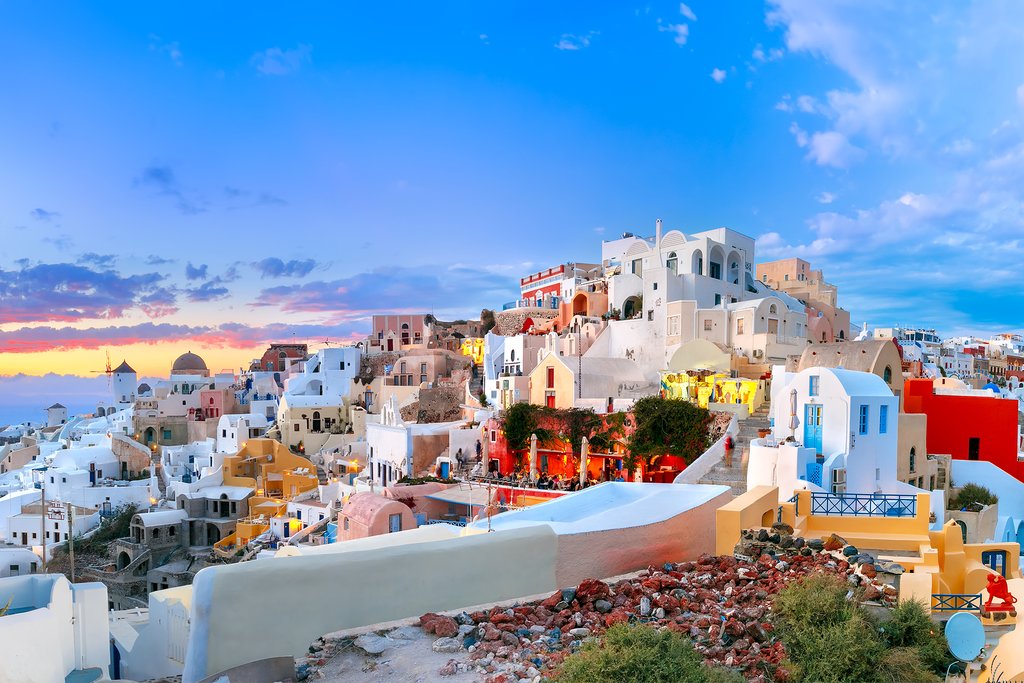
Welcome to Santorini! There's nothing like catching your first glimpse over the island's iconic cliffside architecture. Once settled, watch for your first views of Santorini's central caldera—the site of one of the largest volcanic eruptions in history—rising up in a crescent.
Spend some time after you've settled in to wander the streets of Fira or get beachside. Don't wear yourself out too soon, though, as in the afternoon you'll take a guided tour which will show you a side of Santorini that most travelers don't see.
You'll start with a stroll through famous Oia, where your guide will point out hidden treasures, followed by a trip up to the highest peak on the island, with 360 degree views at the top for the perfect souvenir photo (or five). Then head on to the medieval villages at Megalochori and Pyrgos, which feel a world away from the touristy towns along the caldera rim. Finally, you'll stop for a wine tasting at the caldera's edge to sample varietals dating back centuries as you watch the sun sink into the Aegean.
In the evening, head back to Oia, passing the Blue Dome of Firostefani along your way. The furthest town along the rim of the caldera, Oia's arty streets are the most famous spot for sunset views, but the evening after the crowds have died down is one of the best times to wander the alleys and linger in the town's tavernas. When searching for your dinner, seek out tomato keftedes, deep-fried tomato balls that encapsulate the essence of the Mediterranean diet, and the Santorini specialty spelt pie.
Day 11: Santorini Catamaran Cruise

Enjoy a leisurely morning breakfast with time to stroll through town and scope out the small shops and boutiques. Head over to Fira, the capital of the island, which offers plenty to explore. History buffs will be delighted by proximity to the Archaeological Museum of Santorini, the Museum of Prehistoric Thera, the Folklore Museum of Emmanuel Lignos, and the church of Hypapante.
As the late afternoon unfolds, you'll head toward Vlychada Port to board your semi-private catamaran cruise around the island. Your first stop will be at the Red Beach to swim and sun, followed by a second stop at the White Beach to take in all the distinctive-colored sands of Santorini.
Barbecue will be served onboard while you sail past landmarks at Aspronisi, the Ancient Lighthouse, Indian Rock, and the prehistoric city at Akrotiri, hidden away at the southern tip of Santorini. These ruins are the site of some of the Bronze Age’s most advanced settlements, which prospered for centuries before being destroyed by a great volcanic eruption in the mid-second millennium BC. Top it off with a jump into the hot springs at Nea Kameni, where the mineral-rich volcanic waters are believed to have therapeutic properties.
Day 12: Discover Prehistoric Akrotiri

Take a guided tour of one of the Aegean's most significant prehistoric settlements. You'll head to the excavated city at Akrotiri, hidden away at the southern tip of Santorini on the slopes of the caldera. These ruins were once the site of one of the Bronze Age’s most advanced settlements, which prospered for centuries before being buried by a volcanic eruption in the mid-second millennium BC. You'll have the morning to explore its well-preserved (thanks to the volcanic eruption) streets alongside a local guide who will share its stories.
On your way back, stop to see the three bells of Fira. The trio of bells atop this blue-domed church is pictured on many of the postcards you'll find on the island, it's your turn to take a photo of your own
Unwind on the beach with the remainder of your afternoon. The black sands of Perissa and Kamari are always popular, but the colorful Red or White beach are also well worth seeing. Or seek out some solitude within the cliffs at Koloumbos on the island's northern tip.
Day 13: Ferry to Naxos

Time to ferry over to bustling Naxos after breakfast. With an active main town where you can shop and admire the Venetian architecture, a historic Kastro (castle) area, and expansive beaches, the island offers opportunities for both laidback relaxation, as well as water or land activities. The rest of the day is yours to unwind as you choose. Try out some of these options:
- Hike up to the summit of Mount Zas, the mythological childhood home of Zeus, the ruler of the gods, and the highest point in the Cyclades.
- Head inland to the town of Chalki, home to the island's oldest market and a petite, shady square perfect for whiling away the afternoon. Stop at the kitron distillery to sample the local liqueur and learn about its distillation process over the years.
- Visit the Temple of Demeter at Sangri on your way. Multiple deities of fertility were worshipped here, particularly the goddess Demeter. The temple was constructed in 530 BC, during the tyranny of Lygdamis, and represents a precursor of classical Athenian architecture.
- Stroll to the Portara, the entrance to the Temple of Apollo. Construction on the temple began in the sixth century BCE but was never finished, but the still-standing entranceway has become one of the hallmarks of the island. You can find it on the islet of Palatia, just over a causeway from the heart of Naxos Town (Chora).
For dinner, wander up the hill through the streets of the Kastro neighborhood to pick out your favorite of the area's tavernas, where you can sample the island's fresh produce in its best forms.
Day 14: Ancient Naxos Hike

After breakfast, head to the village of Myli, where you'll pick up an old footpath that leads to the island's ancient aqueduct. Hike up to the nearby quarry, where you'll find two large kouros, unfinished statues of ancient Greek gods, lying on the ground. Originally intended to hold up a temple roof, these giant statues were abandoned by their ancient sculptors when they discovered faults in the marble, but they're no less impressive for that today.
Pass the statues along with olive groves, orchards, and a shady riverside. You'll visit the Catholic church of Theoskepasti, also known as Agios Mamas, the island's oldest chapel, along with Episkopi, the summer residence of the Catholic archbishop, on this 2.5-hour guided hike.
Stop in Mesi Potamia on your way back to town to take a break at a taverna under the trees on the river bank. Spend your afternoon exploring the town along with its neighboring riverside settlements at Ano Potamia and Kato Potamia, connected by a walking path, or return to town for a well-deserved beach break.
Day 15: Horseback Riding in Naxos

Get a different perspective on the island from atop one of its resident horses. The stable will work with you to create a ride that suits your age and skill level to maximize your experience and trail route.
A trip to the village of Apiranthos is a potential ride highlight. Also known as the "marble village" due to its white architecture and marble stone streets, this mountainside spot offers inland views and a slew of museums and crafts to peruse. Listen for the local dialect among the residents, which has remained distinct from the rest of the islands.
Day 16: Naxos to Athens and Depart

It's time to wave goodbye to Naxos! After breakfast, you'll be transferred to either Naxos Port or the island's small airport to return to Athens in time for your departure.
For more tour options, see the 14-day and 15-day versions of this itinerary.


